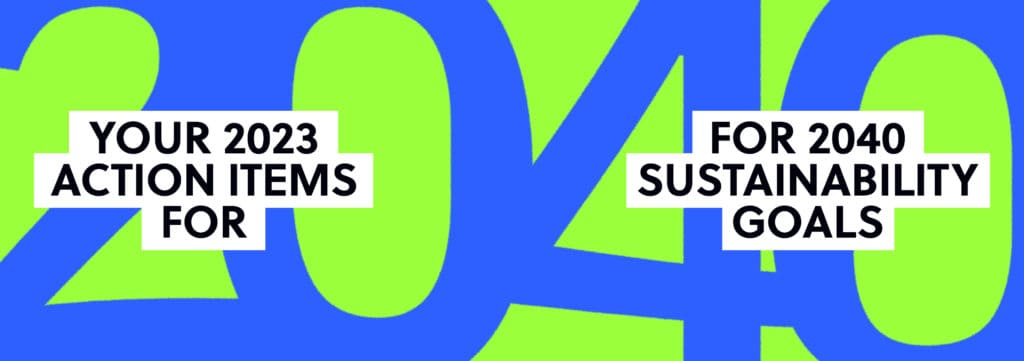Should You Be Stressed About Water Stress?


Your Action Items for 2040 Net-Zero
Over 702 companies on the Forbes 2000 have made net-zero pledges. Whether your organization has made a pledge or plans to make one soon, there’s a massive difference between pledging net-zero and achieving it. Do you have a clear roadmap for your sustainability journey? What are the right steps to consider to achieve 2040 net-zero carbon, water, and waste goals? It’s time to create a clear roadmap.
Discover the critical implications of water stress on businesses, what’s being done about it, and how CarbonBetter can help you.
Water is a critical resource for individuals, businesses, and societies. However, there is a limited supply of usable water, and this supply is being threatened by many factors including climate change, pollution, and overuse. While climate and carbon are often front and center of sustainability discussions, water, and access to it, is a critical consideration for individuals and businesses. While a metric ton of carbon dioxide (CO2) may be hard to visualize, a gallon of water is not. We consume it, we bathe in it, we create products with it, but how often do we think about what it would be like to not have access to it (the nonprofit “Imagine a Day Without Water” encourages us to do just that annually on October 19)? Water-related disasters are on the rise—July 2023 saw record flooding events in the United States (US) in tandem with severe drought currently covering 32% of the US and Puerto Rico.
There are 3 different terms that often play into discussions around water supply and meeting water needs:
- Water scarcity focuses specifically on volumetric supply and demand and is a ratio of water consumption in a given area to the available volume of water in the same area.
- Water stress is a broader term that incorporates water scarcity but also considers water quality, environmental factors, and accessibility of water.
- Water risk refers to the risk of an entity experiencing an adverse water-related challenge due to factors such as water stress, water scarcity, flooding events, water infrastructure issues, etc.
Herein, we are focussed on water stress, which is expected to become an increasingly important issue, with water demand projected to increase 20-25% by 2050. Areas already experiencing high water stress, mainly the Middle East and North Africa, will face the worst of these impacts.
What Is Water Stress and How Does It Relate to Other Facets of Sustainability?
Water stress is inherently linked to climate change. It is hard to turn on the news these days without seeing evidence of water-related hazards and disruptions of weather patterns such as flooding, changes in rainfall and increasingly prevalent drought conditions. While water treatment technology has evolved and improved over time, an increase of four times the progress must be made to meet the United Nations’ (UN) 2030 targets around drinking water, sanitation and hygiene. Today, more than 2 billion people globally still lack access to safe drinking water and more than 733 million people live in regions with critical and high levels of water stress. The UN’s Sustainable Development Goal (SDG) #6 is to ensure availability and sustainable management of water and sanitation for all, but globally we are currently behind in meeting this goal. The UN’s climate action page highlights water as being at the “center of the climate crisis” and details a myriad of sobering statistics around water scarcity and water-related hazards, but the UN also highlights solutions including wetland restoration and climate smart agriculture. The World Resources Institute’s (WRI) Aqueduct tool can be utilized to map the severity of water risks and water stress.
Why Does Water Stress Matter to Your Business?
Water matters to every business, and water stress can bring a variety of risks. However, it’s important to recognize that the impact of water stress varies significantly across different sectors. Industries like consumer packaged goods (CPG) and agriculture bear a heavy burden due to their reliance on consistent water supply for production and cultivation. These sectors are more susceptible to the physical risks outlined below, making water stress a paramount strategic concern. Understanding the unique challenges and impacts for your specific industry is the first step in crafting a resilient response to water stress. The table below details five risk types and examples of mitigating actions that businesses can take to help reduce their exposure to these risks.
Types of Water Stress Risks with Examples and Mitigation Strategies
| Risk Type | Definition | Examples | Mitigating Actions |
| Physical Risk | Physical risk comes from environmental changes that affect water supply and can negatively impact business operations. | 1) Events such as droughts or water contamination can decrease the supply of inputs and cause supply chain disruptions 2) Water stress can lead to stranded assets | 1) Evaluate water stress levels for areas with direct business operations, as well as supply chain operations |
| Policy & Legal Risk | Policymakers will continue to expand regulations around water usage, treatment, and reporting, and businesses need to be sure they can be in compliance. | 1) US EPA water regulations 2) Increased water cut mandates 3) Expanding reporting and disclosure requirements for water | 1) Implement a water monitoring, reporting, and verification (MRV) system 2) Ensure water usage and wastewater treatment is aligned with local and federal regulations |
| Reputational Risk | As general environmental concerns continue to rise, failing to take timely action on water issues can lead to negative reputational impacts for businesses. | 1) Investor and customer preferences are shifting to be more environmentally-conscious 2) For those not impacted by mandatory reporting requirements, voluntary water reporting is becoming increasingly expected out of companies– sustainability standards setters such as SASB and CDP are including water in their reporting frameworks | 1) Be transparent on how business operations are using water 2) Publicly commit to water reduction targets and goals |
| Market Risk | With water stress becoming a more pressing issue around the world, the supply and demand of water is expected to change, which comes with cost implications. | 1) Water scarcity will lead to higher costs for water 2) Sourcing and supply chain issues may arise from price increases or limited availability of inputs and ingredients that are heavily dependent on water, such as agricultural-based inputs | 1) Conduct water risk assessment for suppliers, and consider requiring suppliers to monitor and report on water usage 2) Incorporate water stress and usage of water when selecting new suppliers |
| Technology Risk | Companies may need to adjust business practices to conserve water, and new technologies may be required for this transition. | 1) Upgrading processes with tools and technology for water monitoring, risk assessment, and conservation may require capital investment | 1) Proactively assess operations to identify areas where process changes will be required |

FW Sustainability Report
Learn more about how Fierce Whiskers has made sustainable choices every step of the way by downloading its full sustainability report.
Skip the RFP—CarbonBetter can help
CarbonBetter Certified Offset Portfolios allow carbon buyers to participate in a variety of projects, geographies, and technologies in one simple transaction rather than navigating a lengthy and complex RFP process with multiple carbon market participants.
Learn More about CBCO 22-1While we are seeing many corporations measuring their carbon footprint and setting targets around reducing carbon emissions and working towards net-zero targets, we need more corporations to take on measuring their water consumption, withdrawals and discharges and simultaneously working towards reducing consumption.
What Is Water Positivity?
On the horizon of water sustainability strategies, the concept of “water positivity" is starting to make waves (we’ll look at one example below). Though still a nascent idea, water positivity goes beyond reducing water footprint and aims to contribute more clean water back into the environment than a business consumes, with a goal of aquifer recharge. This approach is about having a net-positive impact, actively enhancing water availability, and quality in water-stressed areas. While achieving water positivity is a complex journey, incorporating it into corporate sustainability agendas could mark a turning point in our global water story. Companies embracing water positivity are taking a bold step, leading the charge in innovative solutions to water stress challenges.
How Are People Addressing Water Stress in the US?
Strategies to address water stress vary globally. Herein, we’ll explore strategies being deployed in the US by government, corporations, and individuals.
Government
The Colorado River has been drying up due to historic drought conditions over the last 20 years and severe and repeated overuse from the states through which the river flows, with California being the largest user. The Federal government has intervened to help the seven states bordering the river to negotiate cuts in withdrawals from the river. In April 2023, the US Department of Interior (DOI) announced $140 million in funding toward 84 water conservation and efficiency projects across 15 states in the Western US. The projects funded by the investment are anticipated to conserve 230,000 acre-feet of water when completed with a key goal of bringing stability to the Colorado River System.
Drought isn’t the only water crisis in which the US government has intervened. In 2014, a water quality crisis emerged in Flint, Michigan due to a change in drinking water supply meant to cut costs which had catastrophic impacts on water quality. In addition to odor and color issues indicating contamination, lead levels were detected well above the safe drinking water threshold. (Note: the Environmental Protection Agency (EPA) acknowledges that any level of lead contamination in drinking water is unsafe.) As an outcome of the crisis, states such as Michigan have tightened up their legislation around lead pipes and drinking water quality. Regulations at the local, state, and federal levels are critical to proactively ensuring access to safe drinking water.
Corporations
As a water-intensive sector, tech corporations are starting to expand their focus on water, with some making commitments to water positivity. This includes both reducing consumption and investing in water replenishment projects. For example, Microsoft’s plan for water positivity by 2030 will utilize an integrated water management system to manage and reuse rainwater and wastewater, water-efficient plumbing fixtures, and investments in various projects including watershed protection and agricultural water efficiency.
Individuals
As individuals, we each have the opportunity and responsibility to do our part in lowering water stress. It’s important to be mindful of irrigation and car washing restrictions that might be implemented locally during times of drought. To minimize irrigation demand, landscaping techniques such as xeriscaping can be deployed and rainwater harvesting can be implemented. Installing low-flow toilets in your home and taking shorter showers are also strategies for individuals to reduce their water impacts.
How CarbonBetter Can Help
As water stress continues to become an increasingly important issue, CarbonBetter can help businesses take early action to mitigate the risks posed by water stress as well as reduce their water impacts. If you haven’t yet conducted a water footprint assessment, we can help to evaluate your water consumption, withdrawals, and discharges. Understanding your water footprint is an important first step to then being able to evaluate water reduction strategies. It’s also important to understand the water stress of your business, including your supply chain. Once you have a handle on your water impacts and water stress, we can also support you with disclosing your water impacts in your annual sustainability report and strategically evaluate ways to mitigate your impacts. In addition to direct reduction strategies, CarbonBetter can help you select carbon credits to offset your carbon footprint that also have water related co-benefits, such as blue carbon credits.
Conclusion
Navigating the complexities of water stress is essential for businesses, as it directly impacts operational stability and long-term sustainability. This journey involves understanding the nuances of water usage, implementing robust conservation strategies, and proactively adapting to global water concerns. No matter where you are in your sustainability journey, we can help. Contact us today to learn more.
Businesses should be concerned about water stress because it directly impacts operational stability, supply chain management, regulatory compliance, and corporate reputation. Industries heavily dependent on water, such as agriculture and consumer packaged goods, can face significant disruptions due to water stress. These challenges range from physical risks, like droughts affecting production, to reputational risks stemming from inadequate environmental responsibility. CarbonBetter assists businesses in navigating these risks by evaluating their water footprint, identifying areas vulnerable to water stress, and developing mitigation strategies that enhance sustainability and resilience.
Water stress can significantly increase operational costs. For businesses reliant on large quantities of water, scarcity can mean higher prices for this essential resource. Additionally, companies may need to invest more in water efficiency technologies, water recycling systems, or compliance with emerging regulatory requirements. There might also be increased insurance costs to cover water-related business interruptions or supply chain disruptions. CarbonBetter can help businesses anticipate these financial impacts by assessing their specific water risks and identifying cost-effective strategies for water efficiency and compliance.
Water stress can disrupt supply chains by affecting raw material availability, production capacity, and transportation. For instance, agricultural inputs might be limited during droughts, or manufacturing plants might reduce outputs due to water shortages. These disruptions can lead to delays, increased costs, and contractual liabilities. Businesses can mitigate these risks by diversifying supplier locations, investing in water-efficient technologies, and requiring suppliers to adhere to water sustainability practices. CarbonBetter can support businesses in developing a resilient supply chain strategy, identifying alternative sourcing options, and establishing supplier sustainability requirements.
While implementing water-saving measures requires upfront investment, it's important to view these costs in the context of long-term savings and risk reduction. Efficient water use can lead to lower utility bills, potential tax incentives, and reduced compliance or litigation costs. Additionally, enhancing water resilience safeguards against future price volatility and supply disruptions. CarbonBetter can assist in quantifying these long-term financial benefits, helping businesses build a compelling business case for investing in water efficiency and sustainability measures.
Addressing water stress begins with understanding your company's water footprint across all operations and supply chains. This involves assessing water usage, identifying areas of high water stress, and recognizing the potential risks. Companies should also stay informed about local water stress issues and regulations. After this assessment, it's crucial to set measurable goals for water usage reduction and implement practices to achieve these targets. CarbonBetter can facilitate this initial assessment, helping companies understand their water-related impacts, set realistic and impactful reduction targets, and integrate effective water management strategies into their broader sustainability efforts.


